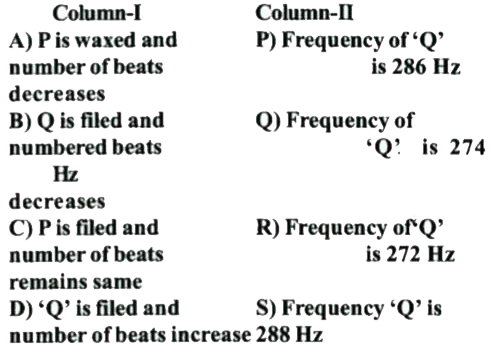A tuning fork P of unknown frequency gives 7 beats in 2 seconds with another tuning fork Q is moved towards a wall with a speed of 5m/s, it gives 5 beats per second for an observer located left to it. On filling, P gives 6 beat per second with Q. The frequency (in Hz) of P is given by (80×α)+β,(α,β∈I,0≤α,β≤9) then find the value of α+β. Assume speed of sound =332m/s.
The correct Answer is:9
_S01_030_S01.png)
Let f1 and f2 be the frequency of tuning forks P and Q, then If1−f2I=7/2
Apparent frequency for O corresponding to signal directly coming from Q=f2(vv+vq)
Apparent frequency of the echo =f2(vv−vq)∴Δf2−f2[2vqvv2−v2q]
Since, Δf2=5 (given) ∴f2=163.5Hz Now, f1=163.5±3.5=167 or 160Hz, when P is filled, its frequency will increase, since it si given that filled P gives greater number of beats with Q. It implies that f1 must be 167Hz.
Topper's Solved these Questions
Similar Questions
A tuning fork P of unknows frequency gives 7 beats in 2 seconds with another tuning fork Q. When Q runs towards a wall with a speed of 5m/s it gives 5 beats per second with its echo. On loading P with wax, it gives 5 beats per second with Q . What is the frequency of P? Assume speed of sound = 332m/s .
View SolutionA tuning fork A frequency 384Hz gives 6 beats in 2 seconds when sounded with another tuning fork B. What could be the frequency of B?
View Solution
Knowledge Check
A tuning fork 'P' of frequency 280Hz produces 6 beats/s with unknown tuning fork 'Q'
 AABCDQRSRBABCDQRQPCABCDP.QQ.RR.SPDABCDR.SQ.RSR
AABCDQRSRBABCDQRQPCABCDP.QQ.RR.SPDABCDR.SQ.RSRTuning fork A when sounded with a tuning for B of frequency 480 Hz gives 5 beats per second. When the prongs of A are loaded with wax, it gives 3 beats per second. The original frequency of A is
A475HzB485 HzC483 HzD477 HzA tuning fork of unknown frequency produces 4 beats per second when sounded with another tuning fork of frequency 254 Hz. It gives the same number of beats per second when unknown tuning fork loaded with wax . The unknown frequency before loading with wax is
A258B254C250DCan't be determined
A tunning fork of unknown frequency gives 4 beats per second when sounded with a fork of frequency 320 Hz. When loaded with little wax, it gives 3beats per second. Find the unknown frequency. [
View SolutionA fork of unknown frequency gives 4 beats per second when sounded with another of frequency 256. The fork is now loaded with a piece of wax and again 4 beats per second are heard. Calculate the frequency of the unknown fork.
View SolutionA tuning fork of unknown frequency gives 4beats with a tuning fork of frequency 310 Hz. It gives the same number of beats on filing. Find the unknown frequency.
View SolutionWhen a tuning fork A of unknown frequency is sounded with another tuning fork B of frequency 256Hz, then 3 beats per second are observed. After that A is loaded with wax and sounded, the again 3 beats per second are observed. The frequency of the tuning fork A is
View SolutionA tuning fork A of frequency 512 Hz sounded with another tuning fork B gives 5 beats/sec. On loading B with a piece of wax, and on sounding, again 5 beats/sec are produced. Calculate the frequency of fork B.
View Solution
